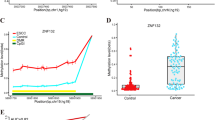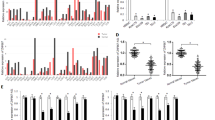Abstract
Frequent deletions of tumor-suppressor genes at chromosome 3p21.3 have been detected in esophageal squamous cell carcinoma (ESCC). As a candidate tumor suppressor gene, semaphorin 3B (SEMA3B) is located at 3p21.3 and is frequently inactivated in several tumors. However, the role and inactivation mechanisms of SEMA3B and its antisense long non-coding RNA (lncRNA) SEMA3B-AS1 in the carcinogenesis of ESCC have not been fully elucidated. The present study was conducted to investigate the role, epigenetic inactivation mechanisms, and prognostic value of SEMA3B and SEMA3B-AS1 in ESCC tumorigenesis and prognosis. Frequent downregulation of SEMA3B and SEMA3B-AS1 was detected in esophageal cancer cells and ESCC tissues, and the expression level of SEMA3B and SEMA3B-AS1 in ESCC tissues was correlated with TNM stage and lymph node metastasis. SEMA3B and SEMA3B-AS1 shared the same CpG island in the promoter region and the expression of both genes might be regulated by the promoter methylation status. Furthermore, transcription factor Sp1 activated SEMA3B or SEMA3B-AS1 transcription and the promoter hypermethylation of SEMA3B and SEMA3B-AS1 influenced Sp1 binding ability. Moreover, over-expression of SEMA3B and SEMA3B-AS1 suppressed the viability and invasion of esophageal cancer cells in vitro. SEMA3B-AS1 influenced the protein expression of SEMA3B. SEMA3B or SEMA3B-AS1 expression and promoter methylation status were correlated with ESCC patients’ survival. Thus, these findings suggest that SEMA3B and SEMA3B-AS1 may act as tumor suppressors and may serve as potential targets for antitumor therapy.







Similar content being viewed by others
References
Lambert R, Hainaut P (2007) The multidisciplinary management of gastrointestinal cancer. Epidemiology of oesophagogastric cancer. Best Pract Res Clin Gastroenterol 21:921–945
Herszényi L, Tulassay Z (2010) Epidemiology of gastrointestinal and liver tumors. Eur Rev Med Pharmacol Sci 14:249–258
Pennathur A, Gibson MK, Jobe BA, Luketich JD (2013) Oesophageal carcinoma. Lancet 381:400–412
Guohong Z, Min S, Duenmei W, Songnian H, Min L, Jinsong L, Hongbin L, Feng Z, Dongping T, Heling Y, Zhicai L, Shiyong L, Quansheng G, Xiaoyun L, Yuxia G (2010) Genetic heterogeneity of oesophageal cancer in high-incidence areas of southern and northern China. PLoS ONE 5:e9668
Luo Y, Raible D, Raper JA (1993) Collapsin: a protein in brain that induces the collapse and paralysis of neuronal growth cones. Cell 75:217–227
Gaur P, Bielenberg DR, Samuel S, Bose D, Zhou Y, Gray MJ, Dallas NA, Fan F, Xia L, Lu J, Ellis LM (2009) Role of class 3 semaphorins and their receptors in tumor growth and angiogenesis. Clin Cancer Res 15:6763–6770
Chen R, Zhuge X, Huang Z, Lu D, Ye X, Chen C, Yu J, Lu G (2014) Analysis of SEMA3B methylation and expression patterns in gastric cancer tissue and cell lines. Oncol Rep 31:1211–1218
Loginov VI, Dmitriev AA, Senchenko VN, Pronina IV, Khodyrev DS, Kudryavtseva AV, Krasnov GS, Gerashchenko GV, Chashchina LI, Kazubskaya TP, Kondratieva TT, Lerman MI, Angeloni D, Braga EA, Kashuba VI (2015) Tumor suppressor function of the SEMA3B gene in human lung and renal cancers. PLoS ONE 10:e0123369
Castro-Rivera E, Ran S, Brekken RA, Minna JD (2008) Semaphorin 3B inhibits the phosphatidylinositol 3-kinase/Akt pathway through neuropilin-1 in lung and breast cancer cells. Cancer Res 68:8295–8303
Pang CH, Du W, Long J, Song LJ (2016) Mechanism of SEMA3B gene silencing and clinical significance in glioma. Genet Mol Res. https://doi.org/10.4238/gmr.15017664
Song Y, Li L, Ou Y, Gao Z, Li E, Li X, Zhang W, Wang J, Xu L, Zhou Y, Ma X, Liu L, Zhao Z, Huang X, Fan J, Dong L, Chen G, Ma L, Yang J, Chen L, He M, Li M, Zhuang X, Huang K, Qiu K, Yin G, Guo G, Feng Q, Chen P, Wu Z, Wu J, Ma L, Zhao J, Luo L, Fu M, Xu B, Chen B, Li Y, Tong T, Wang M, Liu Z, Lin D, Zhang X, Yang H, Wang J, Zhan Q (2014) Identification of genomic alterations in oesophageal squamous cell cancer. Nature 509:91–95
Bandla S, Pennathur A, Luketich JD, Beer DG, Lin L, Bass AJ, Godfrey TE, Litle VR (2012) Comparative genomics of esophageal adenocarcinoma and squamous cell carcinoma. Ann Thorac Surg 93:1101–1106
Guo W, Cui L, Wang C, Guo Y, Shen S, Kuang G, Dong Z (2014) Decreased expression of RASSF1A and up-regulation of RASSF1C is associated with esophageal squamous cell carcinoma. Clin Exp Metastasis 31:521–533
Yi Lo PH, Chung Leung AC, Xiong W, Law S, Duh FM, Lerman MI, Stanbridge EJ, Lung ML (2006) Expression of candidate chromosome 3p21.3 tumor suppressor genes and down-regulation of BLU in some esophageal squamous cell carcinomas. Cancer Lett 234:184–192
Sawada G, Takahashi Y, Niida A, Shimamura T, Kurashige J, Matsumura T, Ueo H, Uchi R, Takano Y, Ueda M, Hirata H, Sakimura S, Shinden Y, Eguchi H, Sudo T, Sugimachi K, Miyano S, Doki Y, Mori M, Mimori K (2014) Loss of CDCP1 expression promotes invasiveness and poor prognosis in esophageal squamous cell carcinoma. Ann Surg Oncol 21(Suppl 4):S640–S647
Kuroki T, Trapasso F, Yendamuri S, Matsuyama A, Alder H, Williams NN, Kaiser LR, Croce CM (2003) Allelic loss on chromosome 3p21.3 and promoter hypermethylation of semaphorin 3B in non-small cell lung cancer. Cancer Res 63:3352–3355
Grote HJ, Schmiemann V, Geddert H, Rohr UP, Kappes R, Gabbert HE, Böcking A (2005) Aberrant promoter methylation of p16(INK4a), RARB2 and SEMA3B in bronchial aspirates from patients with suspected lung cancer. Int J Cancer 116:720–725
Ito M, Ito G, Kondo M, Uchiyama M, Fukui T, Mori S, Yoshioka H, Ueda Y, Shimokata K, Sekido Y (2005) Frequent inactivation of RASSF1A, BLU, and SEMA3B on 3p21.3 by promoter hypermethylation and allele loss in non-small cell lung cancer. Cancer Lett 225:131–139
Riquelme E, Tang M, Baez S, Diaz A, Pruyas M, Wistuba II, Corvalan A (2007) Frequent epigenetic inactivation of chromosome 3p candidate tumor suppressor genes in gallbladder carcinoma. Cancer Lett 250:100–106
Taft RJ, Pang KC, Mercer TR, Dinger M, Mattick JS (2010) Non-coding RNAs: regulators of disease. J Pathol 220:126–139
Lipovich L, Johnson R, Lin CY (2010) MacroRNA underdogs in a microRNA world: evolutionary, regulatory, and biomedical significance of mammalian long non-protein-coding RNA. Biochim Biophys Acta 1799:597–615
Calore F, Lovat F, Garofalo M (2013) Non-coding RNAs and cancer. Int J Mol Sci 14:17085–17110
Sadeghpour S, Ghorbian S (2018) Evaluation of the potential clinical prognostic value of lncRNA-BANCR gene in esophageal squamous cell carcinoma. Mol Biol Rep. https://doi.org/10.1007/s11033-018-4556-2
Beckedorff FC, Amaral MS, Deocesano-Pereira C, Verjovski-Almeida S (2013) Long non-coding RNAs and their implications in cancer epigenetics. Biosci Rep 33:e00061
Kondo Y, Shen L, Issa JP (2003) Critical role of histone methylation in tumor suppressor gene silencing in colorectal cancer. Mol Cell Biol 23:206–215
Cameron EE, Bachman KE, Myöhänen S, Herman JG, Baylin SB (1999) Synergy of demethylation and histone deacetylase inhibition in the re-expression of genes silenced in cancer. Nat Genet 21:103–107
Livak KJ, Schmittgen TD (2001) Analysis of relative gene expression data using real-time quantitative PCR and the 2(-Delta Delta C(T)) method. Methods 25:402–408
Umemoto M, Yokoyama Y, Sato S, Tsuchida S, Al-Mulla F, Saito Y (2001) Carbonyl reductase as a significant predictor of survival and lymph node metastasis in epithelial ovarian cancer. Br J Cancer 85:1032–1036
Wang JH, Gouda-Vossos A, Dzamko N, Halliday G, Huang Y (2013) DNA extraction from fresh-frozen and formalin-fixed, paraffin-embedded human brain tissue. Neurosci Bull 29:649–654
Yu L, Liu C, Vandeusen J, Becknell B, Dai Z, Wu YZ, Raval A, Liu TH, Ding W, Mao C, Liu S, Smith LT, Lee S, Rassenti L, Marcucci G, Byrd J, Caligiuri MA, Plass C (2005) Global assessment of promoter methylation in a mouse model of cancer identifies ID4 as a putative tumor-suppressor gene in human leukemia. Nat Genet 37:265–274
Loginov VI, Khodyrev DS, Pronina IV, Maliukova AV, Kazubskaia TP, Ermilova VD, Gar’kavtseva RF, Zabarovskiĭ ER, Braga EA (2009) Two CpG-islands of SEMA3B gene: methylation in clear cell renal cell carcinoma. Mol Biol 43:1088–1092
Pelechano V, Steinmetz LM (2013) Gene regulation by antisense transcription. Nat Rev Genet 14:880–893
Heilmann K, Toth R, Bossmann C, Klimo K, Plass C, Gerhauser C (2017) Genome-wide screen for differentially methylated long noncoding RNAs identifies Esrp2 and lncRNAEsrp2-as regulated by enhancer DNA methylation with prognostic relevance for human breast cancer. Oncogene 36:6446–6461
Guo W, Dong Z, Chen Z, Yang Z, Wen D, Kuang G, Guo Y, Shan B (2009) Aberrant CpG Island hypermethylation of RASSF1A in gastric cardia adenocarcinoma. Cancer Invest 27:459–465
Ma X, Yu L, Wang P, Yang X (2017) Discovering DNA methylation patterns for long non-coding RNAs associated with cancer subtypes. Comput Biol Chem 69:164–170
Homma N, Tamura G, Honda T, Matsumoto Y, Nishizuka S, Kawata S, Motoyama T (2006) Spreading of methylation within RUNX3 CpG island in gastric cancer. Cancer Sci 97:51–56
Endoh M, Tamura G, Honda T, Homma N, Terashima M, Nishizuka S, Motoyama T (2005) RASSF2, a potential tumour suppressor, is silenced by CpG island hypermethylation in gastric cancer. Br J Cancer 93:1395–1399
Satoh A, Toyota M, Itoh F, Kikuchi T, Obata T, Sasaki Y, Suzuki H, Yawata A, Kusano M, Fujita M, Hosokawa M, Yanagihara K, Tokino T, Imai K (2002) DNA methylation and histone deacetylation associated with silencing DAP kinase gene expression in colorectal and gastric cancers. Br J Cancer 86:1817–1823
Acknowledgements
This study was supported by Grants from the National Natural Science Foundation (Nos. 81472335, 81572441, 81772612), Natural Science Foundation of Hebei Province (Nos. H2015206196, H2015206420).
Author information
Authors and Affiliations
Corresponding author
Additional information
Publisher’s Note
Springer Nature remains neutral with regard to jurisdictional claims in published maps and institutional affiliations.
Electronic supplementary material
Below is the link to the electronic supplementary material.
Rights and permissions
About this article
Cite this article
Dong, Z., Liang, X., Wu, X. et al. Promoter hypermethylation-mediated downregulation of tumor suppressor gene SEMA3B and lncRNA SEMA3B-AS1 correlates with progression and prognosis of esophageal squamous cell carcinoma. Clin Exp Metastasis 36, 225–241 (2019). https://doi.org/10.1007/s10585-019-09964-3
Received:
Accepted:
Published:
Issue Date:
DOI: https://doi.org/10.1007/s10585-019-09964-3




